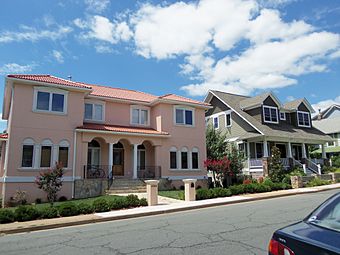Lyon Village, Virginia facts for kids
|
Lyon Village Historic District
|
|
 |
|
| Location | Roughly bounded by Lee Highway, N. Veitch St., N. Franklin Rd., N. Highland St., N. Fillmore St., and N. Kirkwood Rd., Arlington County, Virginia |
|---|---|
| Area | 191 acres (77 ha) |
| Built | 1846 |
| Architect | Lyon, Frank; et al. |
| Architectural style | Late Victorian, Late 19th And 20th Century Revivals |
| NRHP reference No. | 02000512 |
Quick facts for kids Significant dates |
|
| Added to NRHP | May 10, 2002 |
Lyon Village is a neighborhood and "urban village" in Arlington County, Virginia. It's located along Langston Boulevard. This area is right next to Arlington County's government center, which includes the courthouse. It's also about a mile west of Rosslyn and less than a mile north of Clarendon. Some people even consider Lyon Village a part of Clarendon.
Contents
What is Lyon Village Like Today?
A Special Historic District
The Lyon Village Historic District is a special area with over 1,000 important buildings. It's a connected neighborhood in northern Arlington County. You can find it just north of the Clarendon shopping area. It's generally located between Wilson Boulevard to the south and Lee Highway to the north.
Getting Around Lyon Village
Major roads make it easy to get to shops and jobs from Lyon Village. You can quickly reach places in Arlington County and nearby Washington, D.C.. The historic neighborhood covers about 191 acres. It stretches from North Veitch Street in the east to North Kirkwood Road in the west. This is much larger than the original 148 acres planned by Frank Lyon in 1923.
Shopping and Community Spots
Today, the main shopping area in Lyon Village is a "strip mall." It's where Lee Highway, Spout Run Parkway, and Interstate 66 (I-66) all come together. The neighborhood also has a community house. There's a Veterans of Foreign Wars hall nearby too. It's named after John Lyon, the developer's son, who died in World War I. Parts of Lyon Village are close to the Clarendon and Court House Metro stations. These are on Metrorail's Orange Line.
How Lyon Village Started
The Early Days (1800s)
The story of Lyon Village began a long time ago. In 1825, a man named Robert Cruit bought land in the Clarendon area. He was an immigrant from England and used the land for his farm.
Building a Neighborhood (1900s)
In 1923, Robert Cruit's family sold the land to a developer named Frank Lyon. Mr. Lyon then divided the land into smaller pieces. He planned to build homes there, and that's how Lyon Village got its name! Most of the single-family homes you see in the neighborhood were built in the 1920s and 1930s.
Fort Strong, a Civil War fort that once protected Washington D.C., used to be in this area. Now, it's gone. In its place, you can see tall apartment buildings overlooking Interstate 66. In recent years, some older homes have been torn down to build new ones.
How the Streets Were Planned
When Frank Lyon first planned Lyon Village in 1923, he designed it carefully. The streets were lined with trees and had cool traffic circles. The roads curved nicely, and the housing lots were just under one acre each. Some parts of Lyon Village today, like Aurora Heights and parts of Clarendon, actually have homes built before Frank Lyon bought the land. Later, from the 1930s to the 1950s, more blocks were added to Lyon Village. These new parts had a more grid-like street pattern.
Different Home Styles
Lyon Village has many different styles of homes from the 20th century. You can see everything from grand brick houses to smaller, simpler bungalows. The homes were built from the 1880s all the way up to the late 1990s.
You'll find examples of various architectural styles here. These include Queen Anne, Colonial Revival, Craftsman, Tudor Revival, Classical Revival, and Spanish Mission Revival styles. Many of these homes are single-family houses. Along the edges of the neighborhood, there are also apartment buildings, churches, and shops. Many properties have garages or sheds. The homes are set back from the streets, with sidewalks and grassy areas in between.




